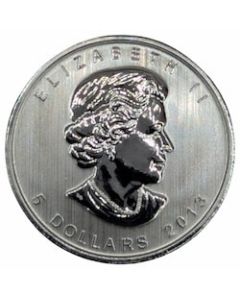Urgent Window of Opportunity: Silver Maple Leaf Coins Could Have a Temporarily Exempt from Tariffs (in March)
In a surprising policy shift, President Trump issued temporary tariff exemptions on 3/6/2025 for a wide range of goods coming into the U.S. from Canada and Mexico, partially reversing the sweeping 25% tariffs he imposed on the two trading partners on 3/4/2025.
The exemptions will apply to goods that are compliant with the North American trade agreement known as the USMCA Agreement. About 50% of Mexican imports and 38% of Canadian imports are covered by the trade agreement. A tentative pause will last until 4/2/2025.
The Royal Canadian Mint's Silver Maple Leaf coins are likely to meet USMCA requirements for preferential tariff treatment, provided they are produced in Canada from silver that either originates within the USMCA region or undergoes the necessary tariff classification change during production. Importers should maintain proper documentation to substantiate the Canadian silver coins' originating status and comply with U.S. customs regulations during importation.
USMCA Qualification Criteria
The United States-Mexico-Canada Agreement (USMCA) provides preferential tariff treatment to goods that meet its rules of origin. For a product like the Silver Maple Leaf coin from the Royal Canadian Mint (RCM) to qualify under USMCA, it must meet specific requirements:
1. Originating Goods Rule
For the Silver Maple Leaf coin to be considered "originating" under USMCA, it must be:
Wholly obtained or produced in Canada, OR
Substantially transformed in Canada, meeting the necessary regional value content (RVC) rules.
2. Canadian Origin of Silver Maple Leaf Coins
The Royal Canadian Mint produces Silver Maple Leaf coins in Canada using high-purity silver (99.99%). For these coins to qualify under USMCA, the key considerations include:
If the silver is mined and refined in Canada, the coins are wholly obtained and meet the requirement.
If the silver is imported (e.g., from Mexico or another country) but refined and minted in Canada, then additional rules like tariff shifts or regional value content tests may apply.
3. Tariff Classification & Tariff Shift Requirement
Silver Maple Leaf coins likely fall under HS Code 7118.90 (coins of precious metal).
If the raw silver is imported and then refined and minted into coins in Canada, it must undergo a tariff shift to qualify as a Canadian-origin product.
The transformation from raw silver (HS 7106) to a minted coin (HS 7118) could satisfy the rule.
4. Regional Value Content (RVC) - If Required
Some goods must meet a percentage-based regional value content test. However, precious metal coins often qualify based on wholly obtained or tariff shift rules, making an RVC calculation unnecessary.
5. Certification for USMCA Preferential Tariff
To claim duty-free treatment under USMCA, the exporter (RCM) or importer (U.S. buyer) must provide a USMCA Certification of Origin, confirming the coins meet the agreement’s rules.
USMCA Tariff Rules for RCM Silver Maple Leaf Coins Explained
To ensure that the Royal Canadian Mint's (RCM) Silver Maple Leaf coins qualify for preferential tariff treatment under the United States-Mexico-Canada Agreement (USMCA), it's essential to understand the agreement's rules of origin and how they apply to these silver coins.
1. USMCA Rules of Origin for Precious Metal Coins
Under the USMCA, goods must meet specific criteria to be considered originating and thus eligible for preferential treatment. For products classified under Chapter 71 of the Harmonized System (which includes precious metals and coins), the agreement specifies:
Wholly Obtained or Produced Goods: Items entirely sourced or produced within the USMCA territories (the U.S., Canada, or Mexico).
Tariff Classification Changes: Goods that undergo a specified change in tariff classification as a result of production processes conducted within the USMCA region.
For precious metal coins, the relevant rule is:
Chapter 71: A change to heading 71.18 from any other heading.
This means that if raw silver (classified under a different heading) is transformed into coins (heading 71.18) within Canada, the coins can be considered originating.
2. Application to Silver Maple Leaf Coins
The Royal Canadian Mint produces Silver Maple Leaf coins with a silver purity of 99.99%. The origin of the silver used is crucial:
Canadian-Mined Silver: If the silver is mined and refined in Canada, the coins are considered wholly obtained and meet the USMCA origin criteria.
Imported Silver: If the silver is sourced from outside Canada but is refined and minted into silver coins within Canada, the transformation must result in a change in tariff classification to heading 71.18 to qualify as originating.
3. Certification and Importation into the U.S.
To benefit from USMCA preferential treatment when importing these coins into the United States:
Certification of Origin: While the USMCA does not mandate a specific certificate of origin form, importers must have documentation supporting the product's originating status.
U.S. Customs Declaration: Gold coins, medals, or silver bullion are duty-free but must be declared to a U.S. Customs and Border Protection (CBP) Officer upon entry.
Conclusion
If the Silver Maple Leaf coins are made from Canadian-mined and refined silver, they automatically qualify as originating under USMCA. If the silver is imported but processed into coins in Canada, the transformation must meet tariff shift requirements. Given that the RCM mints these coins in Canada, they likely meet USMCA requirements for preferential trade into the U.S.
References:
https://www.help.cbp.gov/s/article/Article-1594?language=en_US
https://mitchelltrade.com/article/determining-origin-under-the-usmca














